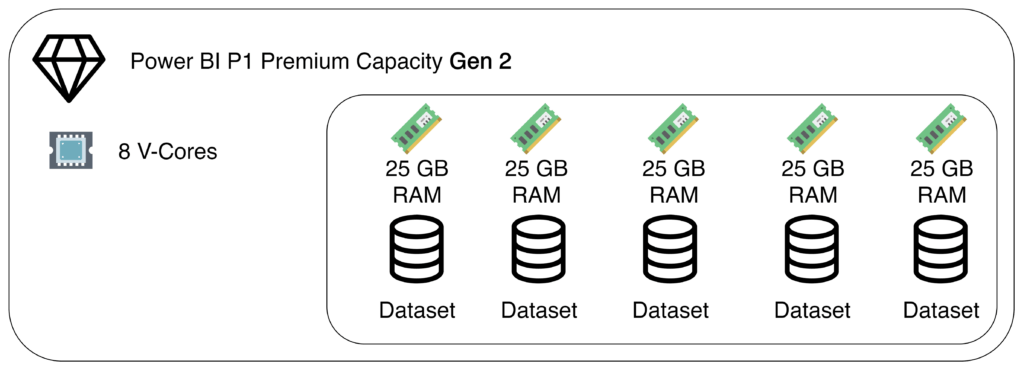Power BI Premium Gen2 is here – everything you need to know about it
This post is also available in:
![]() German
German
It was already announced since the end of 2020 that there would be an update in Power BI Premium capacities. After being in preview for some time, “Generation 2” or “Gen2” short, as the new version is called, is now generally available.
But what is the difference to the current Power BI Premium and what is going to change?
What exactly is Power BI Premium Gen2?
Gen2 is a re-architecture of the existing Power BI Premium capacity. This redesign results in a few changes that are important for the end user and the administrator of the Premium Capacity.
The previous Power BI Premium capacity was the same as renting a physical server. For example, when I rented a P1 capacity, I would get 8 CPU cores and 25 GB of RAM, which were reserved exclusively for me. As a result, I reached the limits of my rented server quite fast. For example, when all my datasets together exceeded 25 GB of RAM or my calculations exceeded the capacity of 8 CPU cores.
Gen2’s concept is more like a software as a service approach. Now all capacities run on regional clusters, where all Premium capacities in that Power BI region are running on. When using my premium capacity, I am now allocated a portion of this cluster, which is significantly more powerful than the previously rented capacity in Gen1. I highly recommend to take a look at the documentation on how the new architecture works.
In detail, this new approach has the following advantages:
Up to 16 x better performance
The changes to the architecture of the Premium capacities basically deliver a significantly better performance than the previous Gen1 Premium capacity. In some cases, this can even mean that reports are up to 16x faster on Gen2 compared to Gen1. In general, performance improvements can be expected for all data sets.
Memory (RAM) per data set and no longer per capacity
The calculation of the allocated memory (RAM) also changes. Previously, all datasets had to share the memory allocated in Premium Capacity. For a P1 node, this means that all datasets have to share the 25 GB, as shown in the following graphic:

In Generation 2, the allocation of the RAM happens per dataset. Therefore, there will be significantly fewer bottlenecks in the RAM in the future. The new system looks schematically like this:

In the future, memory problems should occur much less frequently than in the current premium capacity. The new bottleneck will therefore be the computing power (CPU) in the future.
No limit on the number of concurrent dataset refreshes
Until now, the number of simultaneous refreshes in a premium capacity was limited. For example, with a P1 capacity, there was a limit of maximum 6 simultaneous refreshes. With Gen2, this limitation is completely removed. All datasets can be updated at the same time. As mentioned at the beginning, Gen2 is about virtual CPUs, so the CPU load is the limit, but for the data refresh spread over a 24-hour window. This means that very high-performance loading is possible. The CPU load of a whole day must simply not be exceeded. You can find all the details about how the load is calculated in the official documentation.
Automatic scaling of capacity resources in case of shortages
Also available in Power BI Premium Gen2 is the ability to scale the capacity automatically. If there is ever a shortage of available capacity, Power BI can automatically scale up to the next highest level of capacity for 24 hours. This option must be activated explicitly, as this could become cost-intensive under certain circumstances.
The feature is intended to compensate for temporary peaks, e.g. in the case of temporary higher workloads such as reporting at the change of the month. If a capacity is constantly running at its limit, switching to the next higher capacity or optimizing the reports is a much better way to go.
More information about autoscale is available in the documentation of the feature.
Change to the new capacities by January 15 latest
As mentioned, a change to the new architecture is possible starting from now. This requires only one option to be changed in the Power BI Admin Center:

Basically, Gen1 will be shut down in the close future. Beginning November 15, Tenant Admins will be notified to upgrade to Gen2. According to the current information, all Gen1 capacities will automatically be converted to Gen2 on January 15, 2022.
